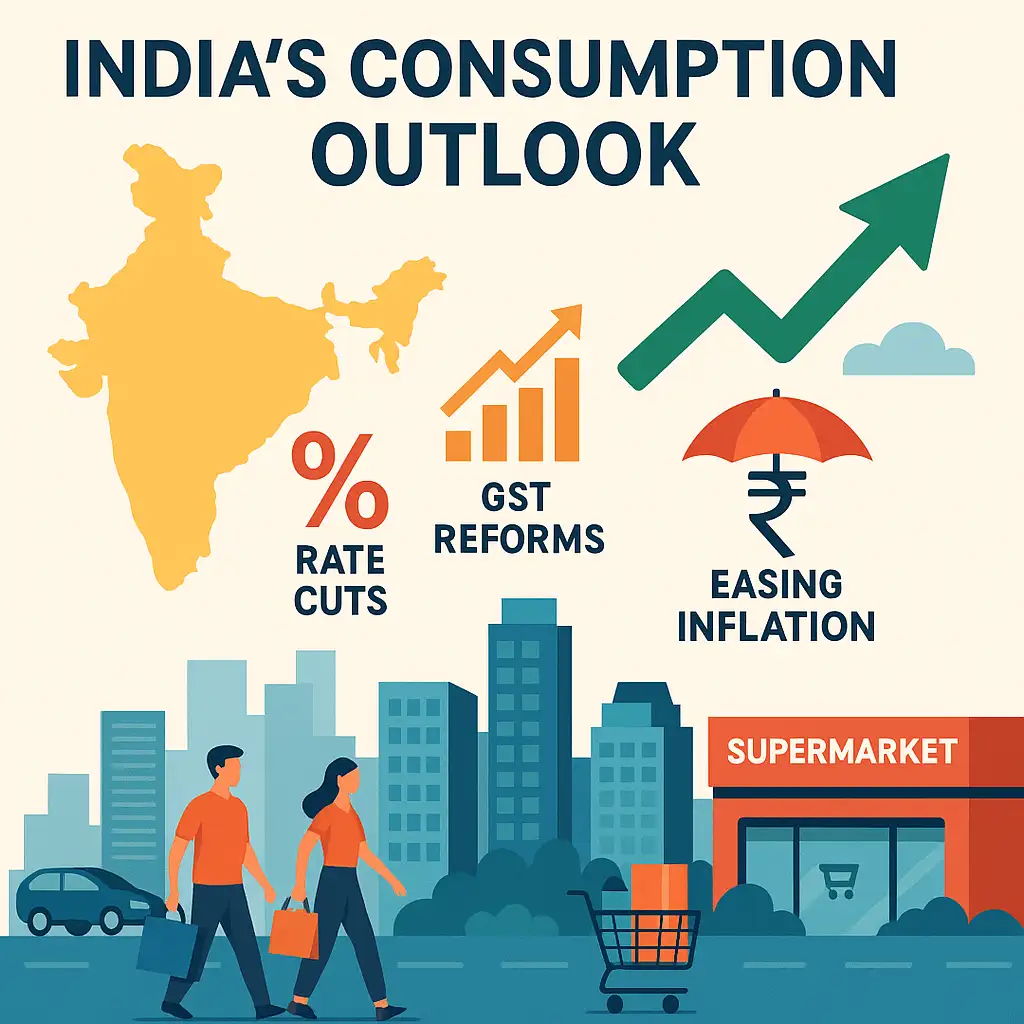India’s Consumption Story: H2 FY2026 and Beyond
India’s consumption engine is poised for a powerful revival in the second half of FY2026, supported by what can be termed the “regulatory trident” of tax cuts, rate cuts, and GST rationalization. These policy levers, combined with the twin tailwinds of a better monsoon and easing inflation, are creating a fertile environment for demand recovery. Together, they promise to release additional disposable income, reduce borrowing costs, and lower retail prices, offering a significant boost to household spending.
Inflation, Liquidity, and Monetary Conditions
The macroeconomic backdrop is far more favorable than it has been in years. Inflation, which has long been a key constraint on consumer budgets, has moderated sharply. CPI fell from 6.2% in October 2024 to just 2.1% by June 2025, dipping further to 1.6% in July before stabilizing at 2.1% in August. Wholesale inflation followed the same trend, turning negative by mid-2025 (-0.58% in July) before recovering slightly. Food inflation, which had surged above 10% in October 2024, cooled dramatically to negative territory by June–July 2025, reaching -1.8%. This easing of price pressures coincided with a dramatic improvement in system liquidity. After showing stress in January–February 2025, when liquidity briefly turned negative (-₹50,000 crore net), the system swung into a deep surplus. By July 2025, net liquidity had surged to over ₹4.0 lakh crore, and remained high at ₹3.97 lakh crore in August 2025. This liquidity cushion has helped transmit at least part of the RBI’s 100-basis-point repo rate cut into lower lending rates for housing, auto, and consumer durable loans.
RBI’s Policy Pause and Consumption Outlook
The Reserve Bank of India’s decision in October 2025 to keep the repo rate unchanged at 5.5% underscores confidence in India’s growth momentum and price stability. By maintaining its neutral stance, the RBI is ensuring that the benefits of earlier rate cuts and abundant liquidity continue to flow through the economy. For households, this provides stability in borrowing costs, reinforcing the consumption recovery already supported by low inflation, GST rationalisation, and improving rural demand. Together, these conditions are expected to strengthen discretionary spending in H2 FY2026 and sustain the broader consumption cycle.
Impact on the Middle Class and Discretionary Spending
These changes are particularly significant for India’s middle class, which historically has allocated the bulk of its income to obligatory expenses such as food, utilities, education, and healthcare. With inflation under control and liquidity abundant, households now have greater flexibility to spend on consumer durables, electronics, mobility, lifestyle products, and leisure activities.
Early signals of this shift are visible in the marketplace as rural households are trading up to “affordable premium” FMCG products, and sales of televisions, refrigerators, and air-conditioners are picking up as GST cuts filter through to retail prices. While there may be short-term disruptions as traders adjust inventories to the new tax regime, the longer-term trend clearly points to rising discretionary demand.
Digital Multiplier and Quick Commerce
The digital economy is amplifying this trend. India’s e-retail market, valued at about $60 billion in FY2025 with more than 270 million shoppers, is projected to nearly triple to $170–190 billion by 2030. Nearly 60% of new shoppers over the last five years have come from Tier-3 and below towns. Quick commerce already accounts for about 10% of e-retail spending and is growing at 35–40% annually, led by groceries, personal care, and daily essentials. As affordability improves and digital access deepens, discretionary demand in India’s smaller towns is set to expand rapidly, creating a powerful second engine of consumption growth.
GDP Outlook and Multiplier Effect
Private final consumption expenditure, which makes up roughly 61.4% of India’s GDP, is expected to accelerate meaningfully in H2 FY2026. The RBI currently projects GDP growth at 6.5% for FY2026, but with the combined effect of lower inflation, abundant liquidity, and GST reforms, there is upside potential for growth to inch closer to 7% in FY2027. Rising consumption will not only boost output directly but also set off a virtuous cycle of investment, credit growth, and job creation.
Risks to Watch
The outlook, however, is not without risks. Transmission of monetary easing remains incomplete, with banks passing through only 20–30 basis points of the 100-basis-point repo cut to their MCLR. A sudden food or fuel price shock could undo much of the inflation relief, while fiscal pressures from tax concessions need careful balancing. Global headwinds, including trade tensions and supply-chain disruptions, also remain a concern.
Conclusion
While risks around monetary transmission, and global headwinds remain, the overall backdrop is far more supportive than in recent years. A stronger monsoon this year is expected to boost agricultural output, leading to improved rural incomes and healthier cash flows. This, in turn, should support a pickup in rural consumption and complement the recovery in urban discretionary demand.
Taken together, households are now simultaneously benefiting from low inflation, lower interest rates, abundant liquidity, income tax relief, and GST rate cuts. This rare convergence could mark the beginning of a new consumption cycle. The middle class may finally pivot toward discretionary categories, while Tier-2, 3, and 4 India leapfrogs into the digital consumption economy. If this momentum is sustained, India could reassert its position as the world’s most resilient consumption-driven economy, powering growth well into the latter half of the decade.

